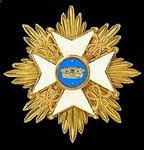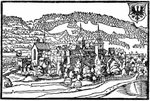This is the second set of cavalry flags commissioned by Lewis Simpson-Jones this summer. As I explained previously, I recreated the cavalry standards and guidons from verbal descriptions in a Spanish source, along with some rather poor 18th century images.
Sagunto Dragoons, then called Camprodon Dragoons, first raised 1703; 500 strong, in 5 squadrons each of 2 companies.
The guidons date from about 1750.
Service:
1703: Blockade of Arronches; sieges of Portalegre and Castelo de Vide
1705: Siege of Gibraltar (failed); occupation of Alcañiz and the castle of Morella
1706: Attack on Villareal; failed defence of Murviedro
1707: Siege and capture of Egea; attack on insurgents at Sábada; relief of Verdun and Borja
1709: Attack on allied camp defending the bridge of Montañana
1710: To Catalonia; battle of Saragossa; combat of Villaviciosa
1711: In the mountains of Aragon and Catalonia; capture of Castle of Arenys and Benasque; failed siege of Cardona
1712: Relief of Arenys
1713: Campaign against the Catalan insurgents
1714: Siege and capture of Barcelona
1715: Now 12 companies of 30 men each
1718: Renamed Sagunto
1720: Coast of North Africa; relief of Ceuta
1721: Back to Spain
1732: Reconquest of Oran, North Africa
1741: To Italy
1743: Passage of the Tanaro and battle of Campo Santo
1745: Siege and capture of Tortona; storm of Piacenza; capture of Parma and Pavia; battle of Bassignano
1746: Battle of Piacenza; battle of Rottofreddo
1747: Retreat to Provence and Languedoc
1748: Return to Catalonia
Seven Years War:
1762: With the Army of Castile for the Invasion of Portugal. Allocated to the Reserve of the army gathered at Zamora. In May the Reserve crossed the Portuguese border and marched on Brandilanes. July 8th it retired to Ciudad Rodrigo. October to cantonments at Malpartida.
(Text summarised from Kronoskaf SYW entry.)
And this was the uniform in the mid-18th century:




















Fantastic stuff David, got a funny feeling a couple of companies went to Cuba in 1762 or they did in my world😀.
ReplyDeleteWillz.
Great, Willz. Look forward to seeing the flags in action with your splendid troops! :-)
DeleteAll the best,
David.
David, you have been on fire the last several days!
ReplyDeleteKind Regards,
Stokes
Thanks, Stokes. Phew - yes, getting very hot here... ;-)
DeleteAll the best,
David.
Another lovely flag and a very different uniform. Busy during the Italian part of the WAS, good to know!
ReplyDeleteThank you, Donnie. :-) The Spanish seem to have kept that yellow right through to the Napoleonic Period at least... Many of the Spanish regiments seem to have been so very busy in the WSS and much less so later.
DeleteAll the best,
David.